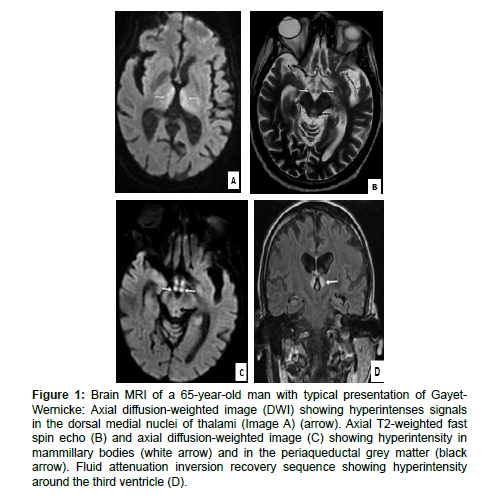Wernicke Encephalopathy after Total Gastrectomy
Received: 02-Nov-2023 / Manuscript No. roa-23-120859 / Editor assigned: 06-Nov-2023 / PreQC No. roa-23-120859 / Reviewed: 20-Nov-2023 / QC No. roa-23-120859 / Revised: 24-Nov-2023 / Manuscript No. roa-23-120859 / Published Date: 30-Nov-2023
Abstract
Gayet-Wernicke encephalopathy is a complication of thiamine deficiency. The prognosis depends on the rapidity of thiamine supplementation. If left untreated, the disease may progress to death. The typical MRI presentation is characterized by hypersignals in the dorsomedian nuclei of the thalami, the mammillary bodies, and the tectal plate, in the periaqueductal region and around the third or fourth ventricle.
Keywords
Wernicke encephalopathy; thiamine; gastrectomy; Brain MRI
Clinical Medical Image
We present the case of a 65-year-old man, without medical history or toxic habits, hospitalized in intensive care for the management of a confusional syndrome occurring 20 days after total gastrectomy for stomach cancer. Clinical examination reveals confused patient with GCS of 6. Thiamine levels dropped to 18 nmol/L (normal 70-180 nmol/L). Brain MRI revealed bilateral and symmetrical hyper signaling in dorsomedial nuclei of the thalami (Figure 1A), mammillary bodies (Figure 1B), periaqueductal region (Figure 1C) and around the third ventricle (Figure 1D). The patient was given a late thiamine supplement, but died.
Figure 1: Brain MRI of a 65-year-old man with typical presentation of Gayet- Wernicke: Axial diffusion-weighted image (DWI) showing hyperintenses signals in the dorsal medial nuclei of thalami (Image A) (arrow). Axial T2-weighted fast spin echo (B) and axial diffusion-weighted image (C) showing hyperintensity in mammillary bodies (white arrow) and in the periaqueductal grey matter (black arrow). Fluid attenuation inversion recovery sequence showing hyperintensity around the third ventricle (D).
Discussion
Wernicke’s encephalopathy is a medical emergency secondary to thiamine (vitamin B) deficiency [1], characterized by a clinical trial of ataxia, ophthalmoplegia and altered mental status [2]. Several clinical situations may explain thiamine malabsorption, such as excessive alcohol consumption, gastrointestinal surgery, prolonged vomiting,chemotherapy, infectious and non-infectious systemic diseases and dietary imbalances [1].
Untreated, prognosis is poor, with the onset of serious neurological disorders such as Korsakoff’s psychosis, and even death. The response is rapidly favorable with thiamine supplementation. MRI appearance is typical, characterized by symmetrical hyper signals in the dorsomedial nuclei of the thalami, mammillary bodies, tectal plate, and periaqueductal region and around the third or fourth ventricle [1, 3].
Differential diagnosis includes Leigh’s disease if mammillary bodies are preserved, metronidazole-induced encephalopathy if cranial nerve nuclei, dental nuclei and splenium are affected, and Percheron’s infactus artery if only thalami are affected.
Author’s Contributions: All the authors contributed to study concept, data analysis and writing the paper.
All authors read and approved the final version of the manuscript.
Conflicts of interest
The authors declare that there are no conflicts of interest regarding the publication of this manuscript.
References
- Zuccoli G, Pipitone N (2009) Neuroimaging findings in acute Wernicke’s encephalopathy: review of the literature. AJR Am J Roentgenol 192: 501–508.
- Sechi G, Serra A (2007) Wernicke’s encephalopathy: new clinical settings and recent advances in diagnosis and management. Lancet Neurol 6: 442–455.
- Sinha S, Kataria A, Kolla BP (2019) Wernicke encephalopathy-clinical pearls. Mayo Clin Proc 94: 1065-1072.
Indexed at, Google Scholar, Crossref
Indexed at, Google Scholar, Crossref
Citation: Benbrahim FZ, Imrani K, Jaheddine F, Moatassimbillah N, Nassar I, etal. (2023) Wernicke Encephalopathy after Total Gastrectomy. OMICS J Radiol 12:507.
Copyright: © 2023 Benbrahim FZ, et al. This is an open-access article distributedunder the terms of the Creative Commons Attribution License, which permitsunrestricted use, distribution, and reproduction in any medium, provided theoriginal author and source are credited.
Share This Article
Open Access Journals
Article Usage
- Total views: 1015
- [From(publication date): 0-2023 - Apr 25, 2025]
- Breakdown by view type
- HTML page views: 791
- PDF downloads: 224

